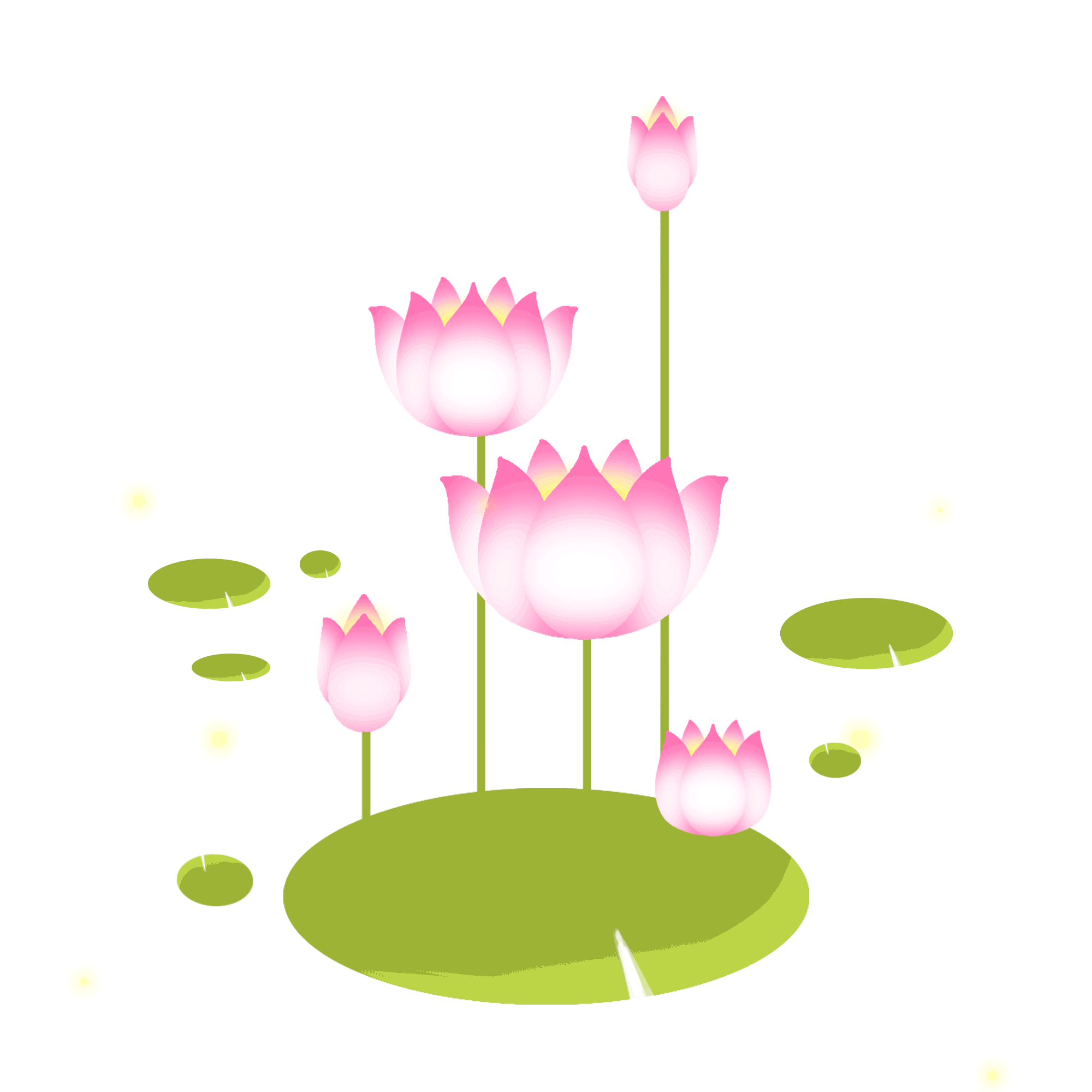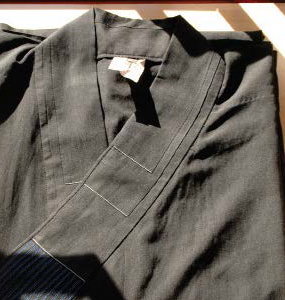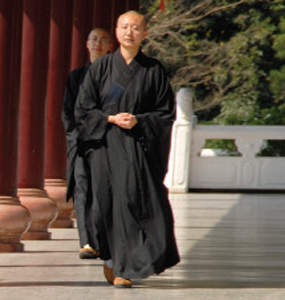“Gracefully moving are the wide dancing sleeves, Like the ocean-blue birds coming from the China Sea.” Disciples look so graceful and solemn when they wear me that long ago people started calling me a haiqing.
Get this book at Buddha's Light Publications.
The haiqing, “ocean blue,” is a traditional Chi-nese robe with wide sleeves. Its waist, lower hem, and sleeves are all loose and wide, making it very comfort-able to wear, and it became the style of dress worn by both Buddhist monastics and laity when paying hom-age to the Buddha. There is a line by the famous Tang poet Li Bai that praises the beauty of the haiqing:
Gracefully moving are the wide dancing sleeves,
Like the ocean-blue birds coming from the China Sea.
The haiqing is also called a dapao, “big robe.” It was adopted by ancient Chan temples because it’s cloth is expansive like the ocean, able to encompass all phenomena, and the graceful waves of its billowing fabric represent unimpeded freedom. The color blue in the name is an allusion to the adage that “blue dye comes from indigo, but surpasses it in color,” just as students surpass their masters generation after gener-ation. It is encouragement to put forth greater effort.
Today the haiqing comes in two colors: black is worn by most Buddhist followers when paying homage to the Buddha, while yellow is worn by the abbot of the temple or the monastic officiating during a Dharma service.
Some call me Han clothing, some call me a haiqing, and still others call me the “big robe.” I received the name of Han clothing because, in ancient China, the Han people wore clothes that looked very similar to me. In Buddhism, disciples wear me when bowing before the Buddha and reciting sutras. Dis-ciples look so graceful and solemn when they wear me that long ago people started calling me a haiqing. The term “haiqing” comes from the name of a large, elegant, and graceful bird found along the shore of Liaodong, China. When this bird spreads its wings, it looks just like my sleeves, so people borrowed the name of this bird to refer to me. During the Tang dynasty, the famous poet Li Bai once praised me in his poetry: “Gracefully moving are the wide dancing sleeves, Like the ocean-blue birds coming from the China Sea.” I am designed differently from other monastic clothing. I am cut large and wide and hang loosely at the waist, sleeves and lower part of my gown. This is why I am also called the “big robe.”
In ancient China, the monastics as well as the laity wore me as their everyday attire. As China became influenced by the West, Chinese dress gradually became Westernized. Lay people no lon-ger wore a haiqing every day. Nowadays, you will not see me any-more unless you go to a monastery or the Chinese opera. At one time, there was a famous photo that showed a man with a bald head wearing a robe that looked a lot like me. People thought he was a famous monk, but when you looked closely, it was clear that he was Wu Qingyuan, a famous weiqi9 master! He had been residing in Japan for many years. People realized that Japan had kept the tradition of wearing ancient Chinese clothing, while the Westernized Chinese had not!
Do not think that I am just a round-collared, square-cut robe. Wearing me could change your status, and people might not rec-ognize you. I remember once when a layperson went to the temple for a Dharma function. His head was shaved like a monk, and as he walked into the temple wearing a haiqing, some pilgrims thought he was an actual monk and gave him red envelopes containing alms. Sigh! I had become a billboard for collecting money! On an-other occasion, seven monastics were officiating at Yogacara Flam-ing Mouth ceremonies.10 When they saw that they were two mo-nastics short, they had no choice but to find two lay persons who knew how to blow the horn and beat the drum. The recruits were given haiqings and dressed up as monastics so that they could help with the service. When people wear the haiqing, no one dares to question whether the person is or is not a monastic.
In some places, so-called monks wear Western-style suits without giving me a thought. I have seen some looking quite like dandies sporting fancy red and green ties and wearing fedora hats. No one would guess that they were monks. If a temple benefactor were to invite one of these Westernized monks to recite a sutra, the monk would have to become like Sun Wukong—the Monkey King11 performing seventy-two transformations—putting on a hai-qing and suddenly becoming a respectable monk!
It is well known that there are no sleeves as big as mine. There is a marvelous story regarding my big sleeves. During the reign of Emperor Wu of the Liang dynasty,12 the emperor’s wife, Chishi was not a Buddhist and always found fault with the monastics. She took pleasure in making false accusations against them. On one occasion, she invited Master Baozhi and his disciples to a banquet, and arranged to have pork stuffed into the buns that were going to be served. If the master and his followers had eaten the pork buns, they would have broken the precepts against eating meat and their reputations would have been tarnished. But if they did not eat the pork buns, they would be insulting the emperor’s consort. During these despotic times, such actions could result in the master and his followers being beheaded.
But Master Baozhi’s wisdom was very deep. He realized what was going on. Before the meal was served, he instructed his dis-ciples to enlarge the sleeves of their haiqings and hide meatless steamed buns in their sleeves. During the banquet they exchanged the meatless buns for the pork buns! In this way they were able to evade the trap that the Empress Chishi had set for them. Although only a legend, this story shows that my big sleeves are far from being useless.
Just as soldiers are required to wear uniforms when on duty and when meeting superior officers, monastics are required to wear me when participating in Dharma functions and when meet-ing with the senior monastics. When a senior monastic comes to a Dharma function not wearing me, another might see this and say, “I am not wearing my haiqing either.” It means: If a monastic is not wearing me, he is not showing proper respect for the sangha. I am the symbol of respect; monastics cannot do without me.
Originally, I was a formal and venerated robe. Monastics were supposed to wear me when prostrating before the Buddha, reciting sutras, and when meeting with others. Some of the more senior meditation practitioners even wore me when they went out shop-ping so that they would reflect the graceful walking of their medi-tation practice. The so-called new generation has already forgotten the history and tradition of wearing me though, and they laugh and make fun of the monastics wearing such strange, old-fash-ioned clothing to the marketplace. The younger monastics reacted to this ridicule by refusing to wear me under any circumstances. New monastic clothing, called arhat clothes,13 was cleverly created and became popular for a while, so people were wearing me less. How could I not be anxious, seeing my power descending like a sunset! I wondered if I would gradually perish.
You might have heard about the movement in Buddhism to reform monastic clothing? Many people found reasons to oppose me. They felt that I used too much cloth, I was too expensive, too loose and big, not neat, inconvenient to wear when working, and that Han clothing was not an essential part of Chinese Buddhism. People wanted to get rid of me and design new monastic attire. A year before he died, Master Taixu14 gave a few newly designed monastic robes to Master Yuanyan, who ordered the production
of new monastic attire according to Master Taixu’s design. In this way, he hoped to show his support for reforming monastic attire. But some conservative monks argued that the current monastic attire was part of a priceless tradition, and they advocated that the traditional monastic attire not be abolished. The new and old were debating with each other! Since there was disagreement within the reform movement, and since China was on the verge of war, the question of reforming me was put on hold. Eventually, my life went on as before.
Originally, I was meant to be made from dyed cloth, and only in the colors of black or gray when worn by monastics. This was to avoid flashy colors. In some places, the monks and nuns wore clothes that clashed with the original intention. Those monks would wear haiqings during funeral services that were colored blue, red, yellow, green, or even multiple colors. They dressed as if they were actors performing on a stage, and as they came out onto their stage, many followers trailed behind them wearing dazzling, multicolored clothes and carrying flags and umbrellas. Some nuns even wore wooden clogs, their silk haiqings dyed white or black, dancing back and forth in the air like butterflies. Even the dress of fashionable young ladies is not as colorful!
The last thing I want to tell you is that I hope the monastics who want to reform monastic attire will reconsider my role. Let the clothing used for daily wear be modified, but do not change me. I should remain as formal attire. I should continue to be worn, but only for Dharma functions and formal occasions. Do not wear me as casual attire and do not make me colorful, as if competing with the clothing worn by fashionable young ladies of the opera. All I ask is to be kept economical and simple. Then I will dance with hands and feet of joy and a voice of thanks.
What's New?
DECEMBER

Humble Table, Wise Fare
INSPIRATION
Recorded by Leann Moore
Being humble before people,
the road is open wherever you go;
being arrogant before people,
it is difficult to move even one step.

Dharma Instruments
Venerable Master Hsing Yun grants voices to the objects of daily monastic life to tell their stories in this collection of first-person narratives.

Sutras Chanting
The Medicine Buddha SutraMedicine Buddha, the Buddha of healing in Chinese Buddhism, is believed to cure all suffering (both physical and mental) of sentient beings. The Medicine Buddha Sutra is commonly chanted and recited in Buddhist monasteries, and the Medicine Buddha’s twelve great vows are widely praised.

Newsletter
What is happening at Hsingyun.org this month? Send us your email, and we will make sure you never miss a thing!







